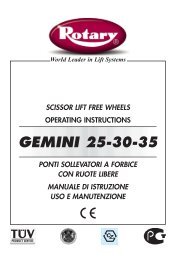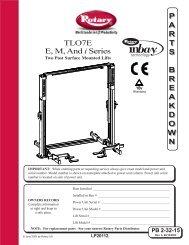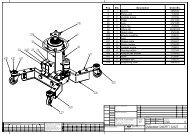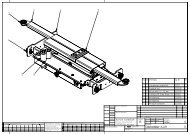Untitled - Trade Garage Equipment
Untitled - Trade Garage Equipment
Untitled - Trade Garage Equipment
- No tags were found...
Create successful ePaper yourself
Turn your PDF publications into a flip-book with our unique Google optimized e-Paper software.
CHAPTER 5 - OPERATIONDRIVING SEQUENCECAP. 5 - FUNZIONAMENTOSEQUENZA DI FUNZIONAMENTOBe sure the platforms are fully closed before gettingon/off the lift. Get in the vehicle and drive on the lift;be sure the vehicle is centred and both rear and frontwheels are properly positioned, place the properrubber pads on the platform (picture 14) so that theyare in line with the lifting points specified by themanufacturer. Press the “lifting” button, keep it presseduntil the required height is reached. To lower the lift,press the “lowering” button (picture 4, pos.2).During the lowering phase, the lift will produce a safetyacoustic signal.During the first hours of operation cracking noisescould occur. This is due to the natural settlement ofmechanical parts and will disappear during thefollowing hours of operation.CHECKSPerform the following checks when operating the car lift:• Carefully check the car lift and its load duringlifting/lowering operation.• Check the warning acoustic signal operation of thecar lift during lowering phase.• ATTENTION: When the lift is operating, there highpressure in the hydraulic pipes (270 bar max).If the plat-forms do not start simultaneously, this might bedue to the following causes :air in the A2 or B2 cylinder and/or differentiated servicepressure in the A2 o B2 line. In this case, repeat theprevious procedure while pistons are at their max. height,operating on the two lines alternatively several times tobleed air and balance the service pressure.Prima di salire/scendere con l’autovettura dal sollevatore,assicurarsi che le pedane siano completamente chiuse.Salire con l’autovettura sul sollevatore moltolentamente assicurandosi che la stessa sia ben centratasulle pedane.Piazzare gli appositi tamponi in gomma sulla pedanadel sollevatore (vedi fig. 14) rispettando i punti disollevamento consigliati dal costruttoredell’autovettura. Premere il pulsante di “salita” e portareil sollevatore all’altezza desiderata.Per la discesa, Premere il pulsante “discesa” (fig. 4 pos 2).Durante la fase di discesa il sollevatore emetterà unsegnale acustico di sicurezza.Nelle prime ore lavorative del sollevatore, potrebberoverificarsi rumori o cigolii dovuti al non ancoraavvenuto assestamento naturale delle partimeccaniche, questo inconveniente sparirà da solo nellesuccessive ore lavorative del sollevatore.CONTROLLIEseguire i seguenti controlli durante il funzionamento delsollevatore:• In fase di salita/discesa osservare costantemente ilsollevatore e il suo carico.• Controllare il funzionamento del segnale acustico diavvertimento nella fase di discesa del sollevatore.• ATTENZIONE: Quando il ponte lavoro c'è altapressione nei tubi idraulici (270 bar max)Qualora si verificasse la partenza slivellata di una delledue pedane, le cause potrebbero essere:aria dei cilindri A2 o B2 e/o pressione di eserciziodifferenziata nelle due linee A2 o B2. In questo casoripetere le operazioni precedenti tenendo presente chel'operazione di spurgo va fatta con i pistoni allamassima altezza, insistendo più volte e alternativamentesu entrambe le linee in modo da liberarle dall'aria edequilibrare le pressioni di esercizio.___________________________________________________________________________19
















